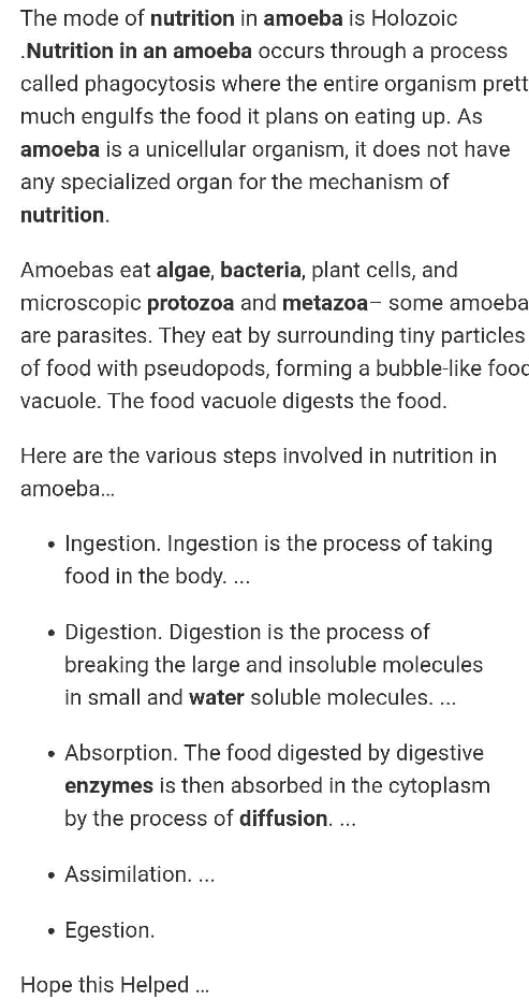Class 10 Exam > Class 10 Questions > Nutrition in amoeba?
Start Learning for Free
Nutrition in amoeba?
Community Answer
Nutrition in amoeba?
Nutrition in Amoeba
Amoeba is a unicellular organism that belongs to the phylum Protozoa. It is an animal-like protist that obtains its nutrition through various modes. The most common mode of nutrition in amoeba is holozoic, which involves the ingestion of solid food particles. Let's discuss the nutrition in amoeba in detail.
Holozoic Nutrition
Amoeba feeds on small organisms such as bacteria, algae, and other protozoans. It captures the prey by extending its pseudopodia around it and engulfing it in a process known as phagocytosis. The food is then enclosed in a food vacuole, where it undergoes digestion. The food vacuole fuses with lysosomes, which contain digestive enzymes that break down the food particles into simpler substances such as glucose, amino acids, and fatty acids. These substances are then absorbed into the cytoplasm of the amoeba for energy production.
Autotrophic Nutrition
Some amoebas have the ability to produce their food through photosynthesis. These amoebas contain chloroplasts, which contain chlorophyll and other pigments that enable them to capture sunlight and convert it into energy. They also require carbon dioxide and water for the process. These amoebas are called mixotrophic because they can switch between autotrophic and heterotrophic modes of nutrition depending on the availability of food.
Saprophytic Nutrition
Some species of amoeba obtain their nutrition by feeding on dead organic matter. They secrete enzymes that break down the organic matter, and the nutrients are then absorbed into the cytoplasm.
Conclusion
Amoeba is a versatile organism that can obtain its nutrition through various modes. The most common mode is holozoic nutrition, which involves the ingestion of solid food particles. However, some species of amoeba can also produce their food through photosynthesis or feed on dead organic matter. Understanding the nutrition in amoeba is crucial for studying the ecology and evolution of these organisms.

|
Explore Courses for Class 10 exam
|

|
Similar Class 10 Doubts
Nutrition in amoeba?
Question Description
Nutrition in amoeba? for Class 10 2025 is part of Class 10 preparation. The Question and answers have been prepared according to the Class 10 exam syllabus. Information about Nutrition in amoeba? covers all topics & solutions for Class 10 2025 Exam. Find important definitions, questions, meanings, examples, exercises and tests below for Nutrition in amoeba?.
Nutrition in amoeba? for Class 10 2025 is part of Class 10 preparation. The Question and answers have been prepared according to the Class 10 exam syllabus. Information about Nutrition in amoeba? covers all topics & solutions for Class 10 2025 Exam. Find important definitions, questions, meanings, examples, exercises and tests below for Nutrition in amoeba?.
Solutions for Nutrition in amoeba? in English & in Hindi are available as part of our courses for Class 10.
Download more important topics, notes, lectures and mock test series for Class 10 Exam by signing up for free.
Here you can find the meaning of Nutrition in amoeba? defined & explained in the simplest way possible. Besides giving the explanation of
Nutrition in amoeba?, a detailed solution for Nutrition in amoeba? has been provided alongside types of Nutrition in amoeba? theory, EduRev gives you an
ample number of questions to practice Nutrition in amoeba? tests, examples and also practice Class 10 tests.

|
Explore Courses for Class 10 exam
|

|
Signup to solve all Doubts
Signup to see your scores go up within 7 days! Learn & Practice with 1000+ FREE Notes, Videos & Tests.




























